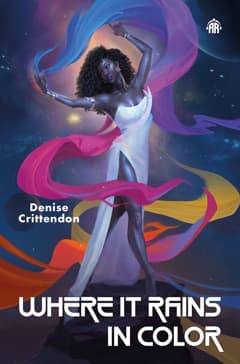
Where It Rains in Color by Denise Crittendon
(Angry Robot, 2022)
Reviewed by Steven French
Lileala is the ‘Rare Indigo’, a title given to the most beautiful woman in the galaxy who is revered for her gorgeous blue-black skin and her ability to produce ‘the Shimmer’, a kind of visible glow. As such, she is about to become a symbolic dignitary and major tourist attraction for her home planet of Swazembi, famed both for its technological superiority and, as a tourist destination, for its misty drifts of electromagnetic colours. With her betrothed, Otto, a respected member of the science-based ‘Pineal Crew’, a glorious future seems to lie at Lileala’s feet.
Then everything starts to fall apart as she begins to hear strange voices in her head and have confusing visions. Even worse, ugly keloids start to erupt across her otherwise perfect skin. In desperation she agrees to take an experimental treatment developed by the Kclabs, a species of translucent creatures who live on another world in comparative poverty and squalor. This requires her to spend time on an asteroid with other afflicted patients and take a daily dose of ‘Mecca’, a serum extracted from Wilfins, a race of eel-like beings driven close to extinction by the Kclabs. While there, the voices in Lileala’s head grow louder and more forceful and the visions reveal her true heritage as a descendant of the Dogon people of West Africa (who, it is claimed, made a number of astronomical discoveries, although such claims have been disputed). With the further revelation as to the origin of both the keloids and the serum, Lileala is finally rescued from the Kclabs and realises her destiny is to be a powerful clairvoyant and living connection between her ancestors and the Swazembian people.
The descriptions of Swazembi culture, including the food, clothes and hairstyles, are rich and evocative and the inhabitants’ use of a kind of energy current—‘the Sweep’—to soar around their city certainly creates some striking images. However, for a book that is billed as ‘Afrofuturist’, it has a curious retro feel to it, with its talk of health ‘oscillators’ and ‘electromagnetic tides’. More importantly, the world-building comes undone at a number of places. So, for example, there is an under-used sub-plot involving the apparent disappearance of another planet in the system but for all their technological superiority, the Swazembians don’t seem to have a basic grasp of orbital dynamics. Likewise, the asteroid on which Lileala finds herself has a gravity that is so ‘thin’ (sic) that one of her fellow patient’s heels can be seen floating above the surface, yet also possesses a perfectly breathable atmosphere, with everyone apparently able to walk and run about as if they were on their home worlds.
Finally, throughout much of the book, Lileala’s character seems quite passive and self-centred—which is no doubt intentional—and it is only towards the very end that she starts to grow and develop as a person. Indeed, as her visions take in the horrific conditions on the slave-ships and plantations endured by her ancestors, together with the civil rights movement as well as the Black Lives Matter protests, there is even the suggestion that she can take on the pain of those who came before and give hope to their spirits. For me, this is where Lileala became more interesting, as I wondered what impact her new status and abilities would have on Swazembi and its relations with its neighbours. No doubt that will be explored in the sequel but then hopefully as much attention will be paid to the background physical details as it is to the aesthetics of Swazembi culture.
Review from BSFA Review 20 - Download your copy here.
